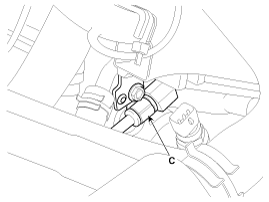Hyundai Kona: Fuel Delivery System / High Pressure Fuel Pump Repair procedures
Hyundai Kona (OS) 2018-2025 Service Manual / Engine Control / Fuel System / Fuel Delivery System / High Pressure Fuel Pump Repair procedures
| Removal |
|
| 1. |
Turn the ignition switch OFF and disconnect the battery negative (-)
cable.
|
| 2. |
Release the residual pressure in fuel line.
(Refer to "Release Residual Pressure in Fuel Line" in this group)
|
| 3. |
Remove the intercooler inlet hoses & pipe.
(Refer to Engine Mechanical System - "Intercooler")
|
| 4. |
Remove the pump foam.
|
| 5. |
Disconnect the fuel pressure control valve connector (A) and the fuel
feed tube quick-connector (B).
|
| 6. |
Remove the high pressure fuel pipe.
|
| 7. |
Remove the installation bolts (D), and then remove the high pressure
fuel pump from the cylinder head assembly.
|
| Installation |
|
|
|
|
|
|
|
|
| 1. |
Install in the reverse order of removal.
|
 High Pressure Fuel Pump Specifications
High Pressure Fuel Pump Specifications
Specification
Items
Specification
High Pressure Fuel Line
bar
20 - 200
MPa
2 - 20
...
Other information:
Hyundai Kona (OS) 2018-2025 Service Manual: Seat Belt Buckle Switch (BS) Components and components location
Components
1. Seat Belt Buckle Switch
(BS)
...
Hyundai Kona (OS) 2018-2025 Service Manual: Cowl Cross Bar Assembly Components and components location
Component Location
1. Cowl cross bar assembly
...
© 2018-2025 www.hkona.com














